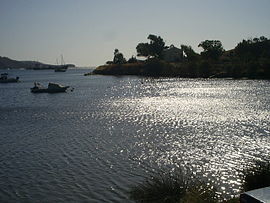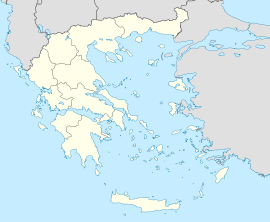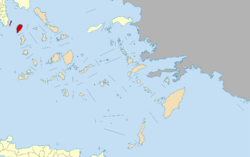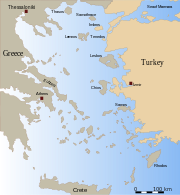- Kea (island)
-
"Ceos" redirects here. For the management occupation, see CEOs."Keos" redirects here. For the radio station, see KEOS.
Kea
Κέα
Kea IslandLocation Coordinates 37°37′N 24°20′E / 37.617°N 24.333°ECoordinates: 37°37′N 24°20′E / 37.617°N 24.333°E Government Country: Greece Region: South Aegean Regional unit: Kea-Kythnos Population statistics (as of 2001) Municipality - Population: 2,417 - Area: 128.9 km2 (50 sq mi) - Density: 19 /km2 (49 /sq mi) Other Time zone: EET/EEST (UTC+2/3) Elevation (min-max): 0 - 560 m (0 - 1837 ft) Postal: 840 02 Telephone: 22880 Auto: ΕΜ Website www.kea.gr Kea (Greek: Κέα), also known as Gia or Tzia (Greek: Τζια), Zea, and, in Antiquity, Keos (Greek: Κέως, Latin: Ceos), is an island of the Cyclades archipelago, in the Aegean Sea, in Greece. Kea is part of the Kea-Kythnos peripheral unit. Its capital, Ioulis, is inland at a high altitude (like most ancient Cycladic settlements, for the fear of pirates) and is considered quite picturesque. Other major villages of Kea are Korissia (the port) and Vourkari (a fishing village). After suffering depopulation for many decades, Kea has been recently rediscovered by Athens as a convenient destination for weekends and yachting trips. The population in 2001 was 2,417.
Contents
Geography
It is the island of the Cyclades complex that is closest to Attica (about 1 hour by ferry from Lavrio) and is also 20 km from Cape Sounio as well as 60 km SE of Athens. Its climate is arid and its terrain is hilly. Kea is 19 km long from north to south and 9 km wide from west to east. The area is 129 km² with the highest point being 560m.
The municipality Kea includes the island of Makronisos to the northwest.
History
Kea is the location of a Bronze Age settlement at the site now called Ayia Irini, which reached its height in the Late Minoan and Early Mycenaean eras (1600-1400 BCE).
In the classical period Kea (Ceos) was the home of Simonides and of his nephew Bacchylides, both ancient Greek lyric poets, and the Sophist Prodicus, and the physician Erasistratus. The inhabitants were known for offering sacrifices to the Dog Star Sirius and Zeus to bring cooling breezes while awaiting for the reappearance of Sirius in summer; if the star rose clear, it would portend good fortune; if it was misty or faint then it foretold (or emanated) pestilence. Coins retrieved from the island from the 3rd century BC feature dogs or stars with emanating rays, highlighting Sirius' importance.[1]
During the Byzantine period many churches were built and the prosperity of the island rose. Kea was Byzantine until, in 1204, it was captured by the Venetians in the wake of the fourth crusade. It was recaptured by the Byzantines under Licario in 1278. In 1296 it fell to the Venetians again, who soon built a castle on the ancient acropolis of Ioulis.
Kea was taken from the Venetians by the Ottoman Turks in 1527. It joined Greece following the Greek War of Independence in 1821, along with the rest of the Cyclades.
HMHS Britannic, the largest ship sunk in World War I and sister ship to the RMS Titanic, was sunk off Kea in 1916.
Historical population
Year Island population 1991 1,797 2001 2,417 Communities
- Chavouna
- Ellinika Kea
- Kato Meria
- Ioulis
- Kea
- Korissia
- Koundouros, Greece
- Otzias
- Pisses
- Vourkari
Notable people
- Aristo (3rd century BC) Peripatetic philosopher
- Prodicus (5th century BC) sophist
- Simonides lyric poet (c. 556 BC-468 BC)
- Bacchylides ( 5th century BC) lyric poet
See also
- Communities of the Cyclades
References
External links
- Official Island website
- An 1885 travel guide to Keos (Zea), an excerpt from James Theodore Bent's The Cyclades, or Life among the Insular Greeks
Islands of the Cyclades Main islands Uninhabited islands Administrative division of the South Aegean Region Area: 5,286km² • Population: 302,686 (2001) • Capital: Ermoupoli Regional unit of Andros Regional unit of KalymnosRegional unit of KarpathosRegional unit of Kea-KythnosKea • KythnosRegional unit of KosRegional unit of MilosRegional unit of MykonosRegional unit of NaxosRegional unit of ParosRegional unit of RhodesRegional unit of SyrosRegional unit of SantoriniRegional unit of Tinos
Regional unit of KalymnosRegional unit of KarpathosRegional unit of Kea-KythnosKea • KythnosRegional unit of KosRegional unit of MilosRegional unit of MykonosRegional unit of NaxosRegional unit of ParosRegional unit of RhodesRegional unit of SyrosRegional unit of SantoriniRegional unit of TinosRegional governor: Ioannis Machairidis • Website: www.pnai.gov.gr Articles on the Aegean Sea GeneralCountries Other Cyclades Amorgos · Anafi · Andros · Antimilos · Antiparos · Delos · Despotiko · Donoussa · Folegandros · Gyaros · Ios · Irakleia · Kardiotissa · Kea · Keros · Kimolos · Koufonisia · Kythnos · Milos · Mykonos · Nata · Naxos · Paros · Polyaigos · Rineia · Santorini · Schoinoussa · Serifopoula · Serifos · Sifnos · Sikinos · Syros · Therasia · Tinos · VousDodecanese Agathonisi · Arkoi · Armathia · Alimia · Astakida · Astypalaia · Çatalada · Chalki · Chamili · Farmakonisi · Gaidaros · Gyali · Imia/Kardak · Kalolimnos · Kalymnos · Kandelioussa · Kara Ada · Karpathos · Kasos · Kinaros · Kos · Küçük Tavşan Adası · Leros · Lipsi · Lebynthos · Nimos · Nisyros · Patmos · Pacheia · Platy · Pserimos · Rhodes · Saria · Salih Ada · Symi · Syrna · Telendos · Tilos · ZaforaNorth Aegean Agios Eustratius · Ammouliani · Ayvalık Islands · Büyük Ada · Chios · Chryse · Cunda · Foça Islands · Fournoi Korseon · Icaria · Imbros · Koukonesi · Lemnos · Lesbos · Metalik Ada · Nissiopi · Oinousses · Psara · Samiopoula · Samos · Samothrace · Tenedos · Thasos · ThymainaSaronic Sporades Adelfoi Islets · Agios Georgios Skopelou · Alonnisos · Argos Skiathou · Dasia · Erinia · Gioura · Grammeza · Kyra Panagia · Lekhoussa · Peristera · Piperi · Psathoura · Repio · Rineia Skyrou · Sarakino · Skandili · Skantzoura · Skiathos · Skopelos · Skyropoula · Skyros · Tsougria · ValaxaCretan Afendis Christos · Agia Varvara · Agioi Apostoloi · Agioi Pandes · Agioi Theodoroi · Agios Nikolaos · Anavatis · Arnaouti · Aspros Volakas · Avgo · Crete · Daskaleia · Dia · Diapori · Dionysades · Elasa · Ftena Trachylia · Glaronisi · Gramvousa · Grandes · Kalydon (Spinalonga) · Karavi · Karga · Katergo · Kavallos · Kefali · Kolokythas · Koursaroi · Kyriamadi · Lazaretta · Leon · Mavros · Mavros Volakas · Megatzedes · Mochlos · Nikolos · Palaiosouda · Peristeri · Peristerovrachoi · Petalida · Petalouda · Pontikaki · Pontikonisi · Praso Kissamou · Prosfora · Pseira · Sideros · Souda · Valenti · VryonisiOther Categories:- Islands of Greece
- Cyclades
- Minoan civilization
- Tourism in Greece
- Municipalities of the South Aegean
Wikimedia Foundation. 2010.






